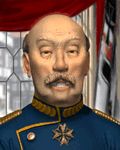The Germans |
|||||||||||||||||||||||
| Profile | |||||||||||||||||||||||
|
|||||||||||||||||||||||
|
German Cities
Great Leaders
|
Background
Julius Caesar’s Gallic Wars brought the Germanic tribes into the spotlight of history. Although Roman efforts to establish hegemony across the Rhine continued for decades, the frontier eventually stabilized along the Rhine and Danube rivers. At that time, Germanic culture extended from Scandinavia as far south as the Carpathians. Although it was heavily fortified, the frontier was never a barrier to trade or culture. Germanic fear of the Huns meant that the Roman Empire could, in moments of crisis, mobilize at least the Goths, Burgundians, and Franks for mutual defense. Soon after Attila’s death in 453, however, the Hun empire collapsed, and Rome lost this hold over the Germans. The Merovigian kings and their Carolingian successors eventually brought much of what would later constitute Germany under Frankish control, but the ceaseless blows from Danes, Saracens and Magyars in the later 9th and 10th centuries weakened the kingdom’s cohesion. Because the Carolingians themselves were unable to provide effective defense for the empire, there arose in nearly all the German lands powerful lines of margraves, counts and hereditary rulers, their intrigues and wars against each other interrupted only briefly by the rise of strong electors such as Frederick Barbarossa (1155-1190). The subsequent history of Germany is, despite the role of the central rule of the Holy Roman Empire, one of the rise and fall of feuding principalities. It would be a thousand years before Germany was again unified under a single ruler. Troubled by the mass insurrections and diplomatic defeats that had followed the Napoleonic Wars, William I of Prussia (1861-1888) considered abdicating in favor of his son, who was believed to have political views close to those of the liberal opposition. He was persuaded, however, to consider forming a new government led by Otto von Bismarck, the Prussian ambassador to Paris. In September 1862, Europe was startled by the news that a statesman with a reputation for conservatism, nationalism and realpolitik had become the prime minister of Prussia. The new German Empire was proclaimed in January 1871, in the aftermath of three short and decisive wars against Denmark, Austria and France by coalitions of German states. Bismarck had unified Germany. The same nationalism that brought unity would bring disaster. Already staggering under a vengeful peace imposed by the Western Allies following World War I, the worldwide economic collapse that began in 1929 proved the catalyst for political extremism. Although bitterly opposed to each other, the Nazis and Communists during the next decade succeeded in mobilizing the political and economic resentments generated by defeat and depression. When Hitler finally became chancellor in January 1933, it was not on the crest of a wave of popular support but as the result of ruthless political intrigue. World War II is appropriately called “Hitler’s War.” Spearheaded by Panzer formations using revolutionary new tactics, Hitler came close to realizing his aim of establishing German hegemony in Europe. But the turning point of the war came with his decision to send his Panzers into Soviet Russia. Though at the end of 1942 an ultimate German victory still seemed possible, by spring 1945 the Third Reich was prostrate. As a legacy of surrender and the ensuing Cold War, a truncated Germany was divided into two zones of military occupation. While under Soviet rule East Germany suffered and stagnated, West Germany’s recovery from total economic and political prostration at the end of World War II was of such dramatic proportions as to become a modern legend. The swift and unexpected downfall of the Soviet order in Europe led to a unification treaty, ratified by the West German Bundestag and the East German People’s Chamber in September 1990. After 45 years of division, Germany was once again a united nation. Unique Unit: the Panzer The Panzer is an upgraded version of the tank. Like the tank, it requires oil and rubber to build, but its additional movement point makes their blitz maneuvers much more dangerous to their enemies, a power which is noted by all nations foolish enough to stand against Germany in the industrial age.
|
||||||||||||||||||||||

 The Germans are scientific and militaristic. They start the game with Bronze Working and Warrior Code and build panzers instead of tanks.
The Germans are scientific and militaristic. They start the game with Bronze Working and Warrior Code and build panzers instead of tanks. Not to be confused with the later Volkswagen, the Panzerkampfwagen (German "armored fighting vehicle") was the mainstay of the German tank forces during World War II. A variety of different models were produced, ranging from lighter, cheaper medium tanks (PzKw IV) to heavier models (PzKw V and VI). Panzer divisions were made famous by the campaigns of German Field Marshal Erwin Rommel ("The Desert Fox") in North Africa.
Not to be confused with the later Volkswagen, the Panzerkampfwagen (German "armored fighting vehicle") was the mainstay of the German tank forces during World War II. A variety of different models were produced, ranging from lighter, cheaper medium tanks (PzKw IV) to heavier models (PzKw V and VI). Panzer divisions were made famous by the campaigns of German Field Marshal Erwin Rommel ("The Desert Fox") in North Africa.